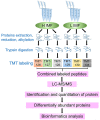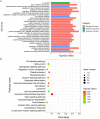Comparative analysis of differentially abundant proteins between high and low intramuscular fat content groups in donkeys
- PMID: 35967999
- PMCID: PMC9364086
- DOI: 10.3389/fvets.2022.951168
Comparative analysis of differentially abundant proteins between high and low intramuscular fat content groups in donkeys
Abstract
Intramuscular fat (IMF) is an important regulator that determines meat quality, and its content is closely related to flavor, tenderness, and juiciness. Many studies have used quantitative proteomic analysis to identify proteins associated with meat quality traits in livestock, however, the potential candidate proteins that influence IMF in donkey muscle are not fully understood. In this study, we performed quantitative proteomic analysis, with tandem-mass-tagged (TMT) labeling, with samples from the longissimus dorsi (LD) muscle of the donkey. A total of 585,555 spectra were identified from the six muscle samples used in this study. In total, 20,583 peptides were detected, including 15,279 unique peptides, and 2,540 proteins were identified. We analyzed differentially abundant proteins (DAPs) between LD muscles of donkeys with high (H) and low (L) IMF content. We identified 30 DAPs between the H and L IMF content groups, of which 17 were upregulated and 13 downregulated in the H IMF group. Gene Ontology (GO) and Kyoto Encyclopedia of Genes and Genomes (KEGG) functional enrichment analysis of these DAPs revealed many GO terms (e.g., bone morphogenetic protein (BMP) receptor binding) and pathways (e.g., Wnt signaling pathway and Hippo signaling pathway) involved in lipid metabolism and adipogenesis. The construction of protein-protein interaction networks identified 16 DAPs involved in these networks. Our data provide a basis for future investigations into candidate proteins involved in IMF deposition and potential new approaches to improve meat quality in the donkey.
Keywords: IMF; differentially abundant proteins; donkey; functional analysis; proteomics.
Copyright © 2022 Tan, He, Qin, Yan, Chen, Zhao, Zhou, Irwin, Li and Zhang.
Conflict of interest statement
The authors declare that the research was conducted in the absence of any commercial or financial relationships that could be construed as a potential conflict of interest.
Figures





Similar articles
-
TMT-labeled quantitative proteomic analyses on the longissimus dorsi to identify the proteins underlying intramuscular fat content in pigs.J Proteomics. 2020 Feb 20;213:103630. doi: 10.1016/j.jprot.2019.103630. Epub 2019 Dec 24. J Proteomics. 2020. PMID: 31881348
-
Comparative transcriptome analysis of longissimus dorsi tissues with different intramuscular fat contents from Guangling donkeys.BMC Genomics. 2022 Sep 9;23(1):644. doi: 10.1186/s12864-022-08857-2. BMC Genomics. 2022. PMID: 36085018 Free PMC article.
-
Proteomic and lipidomic analyses reveal saturated fatty acids, phosphatidylinositol, phosphatidylserine, and associated proteins contributing to intramuscular fat deposition.J Proteomics. 2021 Jun 15;241:104235. doi: 10.1016/j.jprot.2021.104235. Epub 2021 Apr 22. J Proteomics. 2021. PMID: 33894376
-
TRIENNIAL GROWTH AND DEVELOPMENT SYMPOSIUM: Molecular mechanisms related to bovine intramuscular fat deposition in the longissimus muscle.J Anim Sci. 2017 May;95(5):2284-2303. doi: 10.2527/jas.2016.1160. J Anim Sci. 2017. PMID: 28727015 Review.
-
Unraveling the genetic and epigenetic landscape governing intramuscular fat deposition in rabbits: Insights and implications.Food Chem (Oxf). 2024 Aug 30;9:100222. doi: 10.1016/j.fochms.2024.100222. eCollection 2024 Dec 30. Food Chem (Oxf). 2024. PMID: 39290671 Free PMC article. Review.
Cited by
-
Comparative Proteomic Analysis of Glycolytic and Oxidative Muscle in Pigs.Genes (Basel). 2023 Jan 30;14(2):361. doi: 10.3390/genes14020361. Genes (Basel). 2023. PMID: 36833290 Free PMC article.
-
Factors affecting the quality and nutritional value of donkey meat: a comprehensive review.Front Vet Sci. 2024 Sep 6;11:1460859. doi: 10.3389/fvets.2024.1460859. eCollection 2024. Front Vet Sci. 2024. PMID: 39309032 Free PMC article. Review.
-
A review of genetic resources and trends of omics applications in donkey research: focus on China.Front Vet Sci. 2024 Oct 11;11:1366128. doi: 10.3389/fvets.2024.1366128. eCollection 2024. Front Vet Sci. 2024. PMID: 39464628 Free PMC article. Review.
-
Exploring Genetic Markers: Mitochondrial DNA and Genomic Screening for Biodiversity and Production Traits in Donkeys.Animals (Basel). 2023 Aug 27;13(17):2725. doi: 10.3390/ani13172725. Animals (Basel). 2023. PMID: 37684989 Free PMC article. Review.
-
Application of Omics in Donkey Meat Research: A Review.Animals (Basel). 2025 Mar 29;15(7):991. doi: 10.3390/ani15070991. Animals (Basel). 2025. PMID: 40218384 Free PMC article. Review.
References
LinkOut - more resources
Full Text Sources
Research Materials

